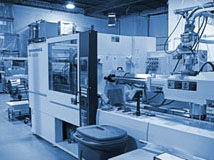Tooling
Progressive Molding Technologies can run your existing tooling, or manage the build of your new tooling through one of our mold-building partners. Whether a new mold is built by the customer or we manage the build, we welcome the opportunity to work with our customers early in the design stages to ensure that the tooling and production process meets their unique requirements.
We strive to meet all of your requirements for injection molds. This includes:
- Consulting services for mold type, construction, and cavitation optimization.
- Mold flow analysis.
- Single cavity prototype tooling in aluminum or tool steel.
- Multi-cavity production molds.
- Mold repair and troubleshooting.
Types of Injection Molds and Terminology
At Progressive we can help you to match the appropriate mold type with your budget or production requirements.
S.P.I. Class I Mold
The Society of the Plastics Industry has developed standards for classifying types of plastic injection molds by their construction. A typical Class I tool is designed for one million cycles. Typical characteristics:
- Multiple cavity and core inserts. This allows for quick repair of an individual cavity.
- Hardened cavity and core inserts for wear resistance.
- Parting line locks for precise alignment of the mold halves.
- Guided ejection, to reduce wear on the ejector pins and inserts.
Cold Runner Injection Mold
The majority of plastic injection molds built are of the cold runner type. In a cold runner mold, the plastic melt is injected into the mold through a sprue and runner where it enters each cavity in the mold. During the cooling stage of the injection molding cycle, the plastic in the cavities, sprue and runner solidify. The sprue and runner become scrap in this type of injection mold. They are then ground into small pieces or pellets and mixed with the virgin plastic for reuse. Cold runner injection molds are more economical to build than hot runner molds, however they can be less economical to run if the amount of plastic in the sprue and runner exceeds 35% of the plastic that is injected into the part cavities.
Hot Runner Injection Mold
A Hot Runner mold uses a heated manifold and sprue bushing to inject the plastic melt directly to the part cavity through a heated nozzle. The advantage of a hot runner mold is that the sprue and runner remain molten, producing no byproducts to be separated or reground. In addition the cycle time is often shortened because the amount of plastic to be melted and then cooled is often drastically reduced. While hot runner molds are typically more expensive than a conventional cold runner tool, they are particularly advantageous for small injection molded parts where the sprue and runner can consist of more than 50% of the total plastic shot per cycle.
Three Plate Injection Mold
A Three plate injection consists of three major components; the runner plate (which is mounted on the stationary platen) contains the sprue and half of the runner geometry, the moveable plate (mounted to the moving platen) contains the ejector system and half the plastic part geometry, and the floating plate (moves freely between the stationary and moveable plates) which contains the other half of the runner geometry and half of the part geometry. As the mold opens, the floating plate and moveable plate remain together, releasing the sprue and runner, while de-gating the plastic part. As the mold continues to open, the floating plate and moveable plate seperate so the plastic parts can be ejected. The advantage of a three plate mold is that it allows precise pinpoint or center gating of the plastic parts. This style mold is generally generally less expensive than a similar hot runner injection mold.
Cavity Set
For short run production or prototyping, it is often advantageous to build a cavity set to fit into a standard prototype mold base. A cavity set generally consists of a single cavity and core insert. The advantage of building a cavity set is short lead time, and low build cost. A cavity set can be used to produce prototype parts, or short run production parts.

